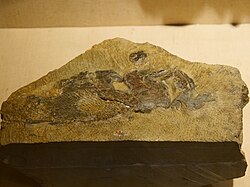Biology:Guiyu oneiros
| Guiyu oneiros | |
|---|---|

| |
| Skeletal reconstruction | |
| Scientific classification | |
| Script error: No such module "Taxobox ranks".: | Animalia |
| Script error: No such module "Taxobox ranks".: | Chordata |
| Script error: No such module "Taxobox ranks".: | Osteichthyes |
| Script error: No such module "Taxobox ranks".: | †Guiyu Zhu et al., 2009 |
| Script error: No such module "Taxobox ranks".: | <div style="display:inline" class="script error: no such module "taxobox ranks".">†G. oneiros |
| Binomial name | |
| †Guiyu oneiros Zhu et al., 2009
| |
Guiyu oneiros is one of the earliest articulated bony fish discovered. Fossils of Guiyu have been found in what is now Qujing, Yunnan, China , in late Silurian marine strata,[2] about 425 million years old.[1]
Guiyu is part of the Xiaoxiang fauna which is rich in fossils representing a marine ecosystem. Found in the late Ludlow-aged Kuanti Formation, the remains were dated using conodonts as index fossils. The Xiaoxiang fauna also includes galeaspids, placoderms and acanthodians.[3]
Discovery and naming
Guiyu was described by Chinese palaeontologist Zhu Min (朱敏) and others in 2009, based on a near-complete articulated specimen. The generic name Guiyu is a transliteration of the Mandarin 鬼魚 guǐyú "ghost fish" and the specific name oneiros is from Greek ὄνειρος "dream".[2]
Description

The holotype specimen is about 26 centimetres (10 in) in length and about 11 centimetres (4.3 in) in depth. The caudal fin has not been preserved, and the living fish is estimated to have been around 30 centimetres (12 in) long.[2] The head made up about 23% of the body length, and the body had a streamlined shape.[2] It possessed several primitive features characteristic of placoderms (jawed stem-gnathostomes) but missing in modern osteichthyans. While the pelvic girdle of modern osteichthyans is made exclusively of endochondral bone, the pelvis of Guiyu included dermal bones as well, including paired lateral plates and an unpaired median plate.[4] The pectoral, pelvic and dorsal fins bore large spines, as seen in many placoderms and acanthodians (basal stem-chondrichthyans). Behind the skull roof there were three median dorsal plates (bones that made up part of the thoracic armour in most placoderms), with the third plate bearing the first dorsal fin spine.[5] The skull bones, scales and other dermal bones were covered in ganoine, a tissue that also covers the scales and cranial bones in basal ray-finned fishes.[2]
Classification

Guiyu was initially described as a basal lobe-finned fish with anatomical features of both ray-finned and lobe-finned fishes.[2] Guiyu sheds light on the early diversification of bony fishes. This clade, the osteichthyans, splits in two clades: the lobe-finned fishes (sarcopterygians) and the ray-finned fishes (actinopterygians). If Guiyu was a sarcopterygian, this split must have already occurred by the late Silurian period, no later than 419 million years ago (original estimate)[2] or 425 Ma (recent estimate).[1] Guiyu has frequently been placed in a clade with three other primitive osteichthyans (Achoania, Psarolepis and Sparalepis); this clade has been informally dubbed the "psarolepids".[6]
The cladogram below follows the analysis of Yu et al. (2010), which recovered Guiyu as a basal sarcopterygian:[7]
| Sarcopterygii |
| ||||||||||||||||||||||||||||||||||||||||||||||||||||||
The many primitive features of Guiyu and other "psarolepids" have led palaeontologists to suggest that they were stem-group osteichthyans instead, lying outside the clade formed by actinopterygians and sarcopterygians. This theory had little support from phylogenetic analyses until the 2017 description of Ptyctolepis, a stem-sarcopterygian from the Early Devonian of China. The accompanying phylogenetic analysis recovered Guiyu and the other "psarolepids" as the sister group of crown-osteichthyans. A cladogram from that study is shown below:[6]
| |||||||||||||||||||||||||||||||||||||||||||||||||||||||||||||||||||||||||||||||||||||||||||
References
- ↑ 1.0 1.1 1.2 Zhao, W.; Zhang, X.; Jia, G.; Shen, Y.; Zhu, M. (2021). "The Silurian-Devonian boundary in East Yunnan (South China) and the minimum constraint for the lungfish-tetrapod split". Science China Earth Sciences 64 (10): 1784–1797. doi:10.1007/s11430-020-9794-8. Bibcode: 2021ScChD..64.1784Z. https://www.researchgate.net/publication/353479392.
- ↑ 2.0 2.1 2.2 2.3 2.4 2.5 2.6 Zhu, M.; Zhao, W.; Jia, L.; Lu, J.; Qiao, T.; Qu, Q. (2009). "The oldest articulated osteichthyan reveals mosaic gnathostome characters". Nature 458 (7237): 469–474. doi:10.1038/nature07855. PMID 19325627. Bibcode: 2009Natur.458..469Z. https://www.researchgate.net/publication/24238222.
- ↑ Zhu, M.; Zhao, W. (2009). "The Xiaoxiang Fauna (Ludlow, Silurian) – a window to explore the early diversification of jawed vertebrates". Rendiconti della Società Paleontologica Italiana 3 (3): 357–358.
- ↑ Zhu, Y.-A.; Wang, Y.-J.; Qu, Q.-M.; Lu, J.; Zhu, M. (2022). "The pelvic morphology of Parayunnanolepis (Placodermi, Antiarcha) revealed by tomographic data". Vertebrata PalAsiatica. doi:10.19615/j.cnki.2096-9899.221126.
- ↑ Zhu, M.; Yu, X.; Choo, B.; Qu, Q.; Jia, L.; Zhao, W.; Qiao, T.; Lu, J. (2012). "Fossil Fishes from China Provide First Evidence of Dermal Pelvic Girdles in Osteichthyans". PLOS ONE 7 (4): e35103. doi:10.1371/journal.pone.0035103. PMID 22509388. Bibcode: 2012PLoSO...735103Z.
- ↑ 6.0 6.1 Lu, J.; Giles, S.; Friedman, M.; Zhu, M. (2017). "A new stem sarcopterygian illuminates patterns of character evolution in early bony fishes". Nature Communications 8 (1): 1932. doi:10.1038/s41467-017-01801-z. PMID 29203766. Bibcode: 2017NatCo...8.1932L.
- ↑ Yu, X.; Zhu, M.; Zhao, W. (2010). "The origin and diversification of Osteichthyans and Sarcopterygians: Rare Chinese fossil findings advance research on key issues of evolution". Bulletin of the Chinese Academy of Sciences 24: 71–75.
Wikidata ☰ Q134934 entry
 |
